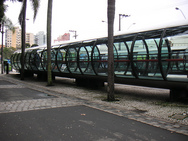Streetcars on the “honor system”
Like most other rail street transit systems in the world, the DC streetcar should operate as a proof of payment honor system. This system requires passengers riding the streetcar to have proof that their current ride is paid for, but does not require riders to show their ticket until asked by an inspector. This system is extensively used in Europe and in various American cities like San Diego, Portland, Phoenix, Dallas, and Los Angeles.
Honor system boarding allows people to board at any door of the vehicle and speeds up vehicle travel speed. If you have a valid day or week pass or prepaid cash ticket, nothing would be required. Just board and go. If you have a SmarTrip card, readers at each door would be available to register your payment. Cash fares could be paid at the driver’s door only, but this could be discouraged by increasing the cash fare (for example, by charging $2.00 at the farebox instead of $1.50 at a ticket vending machine in the station). The goal would be to encourage as many riders to prepay their fares so the boarding process can happen smoothly and with a minimum of delay.
Fare verification would require sampling inspection of tickets. First-time non-payers could be warned, repeat offenders could be fined or (in rare cases) ejected. A reasonable first fine (after a warning) could be $50, with a maximum $200 fine. Citations could be paid by mail or contested at the Metro or DDOT office, with judicial appeals available if required by law. I’m not sure what to do about passengers that are not carrying photo ID. Some systems have difficulty compelling fare evaders to show ID, at worst they could be asked to leave the vehicle.
Having enough inspections to give people more than a 10% chance of being asked to show payment is a reasonable balance between too many inspectors and rampant fraud. With this level of inspection, the TCRP reports that most transit operators see between 1 and 6% non-payment rate. For example, Phoenix’s new light rail transit line reports about a 1% non-payment rate with about a million rides per month. For DC’s streetcar lines, three to five full-time inspectors for each line should be sufficient to provide this level of coverage, supplemented by additional temporary staff inspectors occasionally to provide more robust coverage and audits.
Inspections would be kept brief, paper fare media could be inspected visually, and SmarTrip payment or passes could be validated by hand-held readers. To reduce confrontation and security risks, inspectors might be sent in pairs, boarding the vehicle at both doors and meeting in the middle.
There are some alternatives to the honor system. One would be to require all passengers to board at the front door and pay or show a pass, involving longer waiting times at stops. Another would be to have a conductors at each door (I saw this in Germany) which would increase operating costs. Finally, DDOT could somehow limit access to streetcar stations except through faregates, which is likely impractical or impossible without encasing the station and providing street-side doors like in Curitiba.
Since these alternatives are slower or more expensive, I recommend that DC follow other cities and use proof of payment/honor system for collecting streetcar fares.


